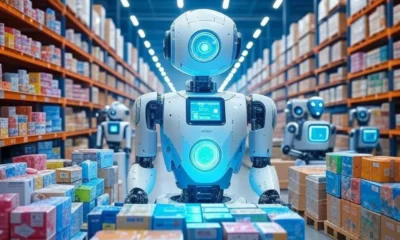Artificial Intelligence
How E-Commerce Stores Use AI for Smart Stock Management
AI transforms e-commerce stock management by predicting demand, avoiding errors, and enhancing efficiency. Stay ahead with dynamic inventory optimization powered by smart technology. Discover how AI elevates your business performance today!

Running an e-commerce store comes with challenges, and stock management often tops the list. Overstocking leads to waste, while stockouts disappoint customers. The good news? AI is reshaping how stock management works, allowing stores to predict demand, automate supply chains, and track inventory in real time. Stick with me as I walk you through how AI is revolutionizing the e-commerce landscape.
Definition
AI-powered stock management uses artificial intelligence technologies to optimize inventory control, supply chains, and customer satisfaction.
How can AI handle stock management so effectively? That’s exactly what I’ll explain in this article. From demand forecasting to fraud detection, I’ll break down how AI makes e-commerce operations smarter and more efficient.
Understanding AI in Stock Management:
AI in stock management is all about automating decision-making processes. AI-powered systems manage inventory levels, predict upcoming product demands, and reduce operational risks. The use of machine learning algorithms, natural language processing, and data analytics enables accurate and dynamic control of stock. For e-commerce businesses, investing in AI ensures smoother workflows and streamlined operations.
Why do businesses need AI?
Traditional inventory management relies on manual processes that are time-consuming and prone to errors. With AI, businesses gain real-time insights, enabling faster and more reliable decisions. AI ensures efficiency and offers data-backed predictions, which means fewer mistakes and better customer satisfaction.
AI-Powered Demand Forecasting:
AI systems analyze historical sales data, customer browsing behaviors, and external factors like holidays and seasons. By observing these trends, AI-powered tools forecast potential spikes or drops in demand. For instance, during Black Friday sales, AI can predict which products will need more inventory based on past purchase trends.
What roles do machine learning models play?
Machine learning models continuously improve over time, analyzing changing customer behaviors and sales patterns. These systems adapt instantly, ensuring accurate predictions that help prevent stockouts and streamline fulfillment.
How does AI enhance targeted promotions?
AI enables businesses to deliver highly personalized promotions by analyzing customer data such as browsing history, purchase preferences, and engagement patterns. Through advanced algorithms, AI identifies the most suitable products or services for each customer segment, ensuring promotional efforts are precise and effective. This level of targeting not only increases conversion rates but also enhances customer satisfaction, as customers are presented with offers aligned with their individual interests.
How does AI optimize inventory in real-time?
AI leverages real-time data from sales channels, supply chains, and even external factors like weather or market trends to optimize inventory. By continuously analyzing this data, AI ensures that stock levels are balanced, minimizing overstocking and understocking issues. This dynamic optimization improves cost efficiency and ensures that customers have access to the products they need without delays, enhancing overall operational performance.
How does AI adjust pricing for maximum sales?
Dynamic pricing powered by AI analyzes market trends, competitor prices, and customer behavior to adjust product prices in real-time. By considering seasonal demand, inventory levels, and customer purchase history, AI identifies the optimal price point that maximizes sales and revenue. This ensures businesses remain competitive in fluctuating markets while aligning prices with consumer expectations.
How does AI analyze customer sentiment for better decisions?
Using natural language processing (NLP), AI can interpret customer reviews, social media mentions, and survey responses to gauge sentiment toward products or services. This sentiment analysis provides actionable insights into customer perceptions, helping businesses identify areas for improvement or opportunities to innovate. With these insights, companies can make more informed decisions to enhance customer satisfaction and loyalty.
How does AI improve supply chain efficiency?
AI transforms supply chain management by streamlining logistics, demand forecasting, and route optimization. By predicting potential disruptions and planning contingencies, AI minimizes delays and reduces operational costs. Additionally, it evaluates supplier performance and tracks key metrics to ensure smooth processes. This enhanced efficiency boosts overall productivity and ensures timely delivery of goods.
How does AI provide automated sales insights?
AI analyzes vast amounts of sales data to generate automated insights that identify emerging trends, customer behaviors, and top-selling products. These insights are presented in user-friendly dashboards, empowering decision-makers to act quickly and effectively. By automating data interpretation, businesses save time and gain a competitive edge in recognizing and capitalizing on new opportunities.
How does AI enhance customer support experiences?
AI improves customer support by powering chatbots, virtual assistants, and automated ticketing systems. These tools provide instant responses to customer inquiries and resolve common issues efficiently. By learning from interactions over time, AI-driven systems become more accurate and intuitive, delivering personalized support experiences. This reduces wait times, increases customer satisfaction, and allows human agents to focus on more complex problems.
Real-Time Inventory Tracking:
What makes real-time tracking essential?
AI-powered inventory systems provide up-to-the-minute updates on stock levels. Whether products are in a warehouse or multiple fulfillment centers, AI tracks them all. This prevents embarrassing situations like selling products that are no longer in stock.
How does this prevent overstocking or understocking?
When demand fluctuates unexpectedly, real-time tracking ensures you’re prepared. AI systems trigger restocking orders automatically, preventing stockouts or overstocks. This balance between supply and demand keeps customers happy and reduces waste.
How does AI track inventory across multiple locations?
AI utilizes interconnected systems and cloud-based platforms to track inventory in real-time, regardless of whether it is stored in one location or across several warehouses and fulfillment centers. Advanced algorithms can analyze data from barcodes, RFID tags, and IoT-enabled devices, ensuring that every product’s location is pinpointed accurately. This seamless tracking reduces the risk of errors and enhances visibility, enabling businesses to manage inventory from a centralized dashboard with unparalleled precision.
How does AI-driven tracking improve order fulfillment?
AI improves order fulfillment by streamlining processes and eliminating inefficiencies. By analyzing customer purchase trends and matching them with inventory data, AI optimizes the picking, packing, and shipping processes. It can prioritize orders based on delivery timelines and recommend the shortest routes for shipments, reducing delays. Additionally, AI minimizes human errors and ensures that customers receive the correct items on time, ultimately enhancing customer satisfaction.
How does AI help reduce inventory holding costs?
AI helps businesses reduce inventory holding costs by maintaining an optimal inventory level. Predictive analytics allow AI to identify slow-moving stock and adjust procurement strategies accordingly, ensuring resources aren’t tied up in unsold goods. Furthermore, AI can suggest efficient storage methods and distribute inventory strategically among multiple locations, minimizing the need for excess storage space while reducing overhead costs.
How does AI predict inventory shortages before they happen?
Leveraging historical sales data and real-time tracking, AI can predict inventory shortages with remarkable accuracy. Machine learning models identify patterns and trends in consumer behavior, seasonal demand, and supply chain dynamics. When a potential shortage is detected, AI alerts businesses in advance so they can reorder stock proactively. This predictive capability mitigates disruptions, maintains steady supply chains, and ensures that customers’ needs are always met.
How does AI improve warehouse efficiency?
AI revolutionizes warehouse efficiency by automating and optimizing operations. Robotics and AI-powered machines assist with tasks such as sorting, picking, packing, and shelving, reducing manual labor. AI systems also analyze the layout of a warehouse to recommend changes that improve workflow and reduce transit times for goods. With reduced bottlenecks and streamlined processes, warehouses operate more efficiently, resulting in faster order processing and delivery.
Automating Supply Chain Decisions:
AI systems analyze data patterns and adjust stock orders accordingly. For example, if demand trends show a sudden rise in smartphone accessories, AI automatically alerts suppliers and places restocking orders. This saves time and minimizes human intervention.
How does AI handle unforeseen demand surges?
AI tools detect demand surges early, thanks to predictive analytics. If a product goes viral unexpectedly, AI ensures supply chains can respond swiftly to avoid missed sales opportunities.
How does AI optimize supplier coordination?
AI optimizes supplier coordination by streamlining communication and automating routine interactions. It leverages real-time data to track supplier performance, monitor inventory levels, and forecast supply needs.
How does AI improve supply chain agility?
AI enhances supply chain agility by providing predictive insights and flexible decision-making models. By analyzing current market trends and environmental data, AI systems allow businesses to quickly adapt to changes, such as sudden shifts in demand or unexpected disruptions.
How does AI minimize delays in logistics?
AI minimizes delays in logistics by identifying potential bottlenecks before they occur. Advanced algorithms track shipment status, predict delays based on weather or traffic conditions, and automatically suggest alternative routes.
How does AI enhance demand forecasting for supply chains?
AI revolutionizes demand forecasting by analyzing vast datasets, including historical sales trends, consumer behavior, and external factors like economic shifts. This detailed analysis creates highly accurate predictions, helping businesses prepare for fluctuations in demand.
How does AI reduce operational costs in supply chain management?
AI reduces operational costs by automating repetitive tasks and optimizing resource allocation. Intelligent systems cut down on waste, lower labor costs by handling processes like order tracking and inventory monitoring, and reduce energy consumption in warehouses.
Preventing Overstock and Reducing Waste:
AI identifies slow-moving products and implements solutions such as discounts or bundling. By recognizing patterns, it avoids excess inventory accumulation, freeing up valuable warehouse space and capital.
Does dynamic pricing play a role?
Yes! AI uses dynamic pricing strategies to move excess inventory by adjusting prices according to demand. Coupled with AI-based discount plans, this ensures better profit margins while clearing stagnant stock.
How does AI predict slow-moving inventory?
AI analyzes historical sales data, current trends, and customer behavior to identify products with declining demand. Using predictive analytics and machine learning, it forecasts which items are likely to remain unsold, allowing businesses to take proactive measures like adjusting marketing efforts or reducing order quantities.
How does AI optimize warehouse space usage?
Through advanced analytics, AI evaluates inventory levels, product dimensions, and sales frequency to determine the most efficient storage strategy. By prioritizing high-demand items for accessible locations and reorganizing slow-moving inventory, AI helps maximize warehouse efficiency and reduces operation costs.
How does AI use dynamic pricing to clear stock?
AI combines real-time data on market trends, competitor pricing, and customer demand to create optimized pricing strategies. By dynamically adjusting prices, AI ensures that excess or stagnant inventory moves faster, balancing profitability with customer satisfaction.
How does AI improve inventory turnover rates?
AI facilitates better inventory turnover by accurately predicting demand, preventing overordering, and automating restocking schedules. It helps businesses maintain the ideal stock levels needed to avoid both shortages and overstock situations, ensuring smooth inventory flow and consistent sales cycles.
How does AI help businesses manage seasonal demand fluctuations?
AI models seasonal trends by analyzing historical sales patterns, weather data, and market conditions, enabling businesses to anticipate demand changes. It automates inventory planning to scale stock up or down as needed, ensuring optimal availability during peak seasons without accumulating excess inventory during off-peak periods.
AI-Powered Warehouse Management:
AI examines inventory movements and allocates storage for maximum efficiency. With optimal layouts, employees can locate and pack products faster, reducing delays.
What role do AI robots play?
AI-driven robots handle tasks like picking and packing orders, minimizing errors caused by human oversight. Using robots not only speeds up fulfillment but also reduces labor costs significantly.
How does AI optimize storage allocation?
AI optimizes storage allocation by analyzing factors such as item demand, size, and compatibility with nearby products. By placing high-demand items in more accessible locations and grouping frequently purchased items together, AI ensures faster retrieval and reduced transit times within the warehouse.
How does AI reduce order fulfillment time?
AI reduces order fulfillment time by streamlining the entire process, from order placement to delivery. Predictive analytics identify the fastest packing and shipping routes, while AI-powered systems coordinate with robots and workers to pick and pack orders more efficiently, ensuring swift turnarounds.
How does AI minimize warehouse operational costs?
By automating repetitive and labor-intensive tasks, AI significantly cuts labor costs. Additionally, it reduces energy consumption through optimal resource allocation and enhances inventory turnover by ensuring better stock management. This comprehensive approach allows businesses to save on overall operational expenses.
How does AI improve accuracy in inventory management?
AI excels in inventory management by leveraging real-time tracking and monitoring systems. Machine learning algorithms predict restocking needs, preventing both overstocking and stockouts. By identifying discrepancies immediately, AI eliminates human errors and ensures accurate inventory records.
How does AI enhance worker productivity in warehouses?
AI enhances worker productivity by assigning tasks based on real-time data and workload distribution. Collaborative robots, or cobots, assist workers in physically demanding tasks, reducing fatigue and increasing efficiency. AI tools also provide actionable insights, enabling workers to focus on high-priority tasks and complete them with precision.
Personalized Stock Allocation for Different Locations:
For stores with multiple warehouses, AI assigns products based on regional demand. For instance, if one area sees increased demand for winter wear, AI redirects inventory to fulfill these needs faster.
Does this improve delivery speed?
Absolutely. When products are closer to target regions, shipping times shrink. This quicker delivery improves customer experience and encourages repeat purchases.
How does AI improve delivery speed?
AI leverages real-time data to optimize delivery routes and prioritize shipments based on urgency. By analyzing traffic patterns, weather conditions, and delivery constraints, AI ensures that drivers take the fastest and most efficient paths. This not only reduces delivery times but also minimizes delays caused by unexpected obstacles.
How does AI reduce shipping costs through better allocation?
AI analyzes historical sales data, seasonal trends, and regional demand to allocate inventory to the most strategic locations. By distributing products closer to customers before orders are placed, shipping distances and associated costs decrease significantly. This smarter allocation helps businesses save on transportation while maximizing efficiency.
How does AI prevent stock imbalances across locations?
Through predictive analytics, AI identifies potential overstock or stockout situations before they occur. By monitoring real-time inventory levels and sales activity, AI automatically triggers stock transfers between warehouses or recommends restocking specific products. This keeps inventory balanced and ensures all locations are adequately supplied to meet customer demand.
How does AI enhance supply chain efficiency?
AI-powered systems provide end-to-end visibility across the supply chain, helping businesses identify bottlenecks and inefficiencies. Machine learning algorithms analyze operations to suggest improvements, whether in production scheduling, warehouse organization, or transportation logistics. This leads to faster processing, reduced waste, and a more streamlined supply chain.
How does AI improve customer satisfaction with faster fulfillment?
By optimizing every aspect of the logistics process, AI enables faster order fulfillment. Accurately predicting demand, ensuring products are positioned close to customers, and minimizing delivery times all contribute to a seamless shopping experience. Satisfied with the speed and reliability, customers are likely to return, fostering brand loyalty.
Fraud Detection and Stock Security:
AI detects unusual inventory patterns or suspicious activities, such as theft or loss during transit. Advanced systems alert managers instantly, reducing potential financial losses.
Can AI track lost items?
Yes, AI locates misplaced inventory by cross-referencing tracking data, ensuring no product goes unnoticed. Its precision significantly reduces shrinkage rates.
How does AI track lost or misplaced items?
AI employs sophisticated tracking systems that integrate with RFID tags, barcodes, and IoT sensors to monitor the movement of items throughout the supply chain. By analyzing real-time data, AI identifies discrepancies or irregularities in the expected location of goods. This proactive approach allows warehouse staff to quickly locate and recover lost or misplaced items, optimizing operational efficiency.
How does AI reduce shrinkage rates?
Shrinkage, whether due to theft, administrative errors, or product damage, is a common issue in inventory management. AI helps reduce shrinkage by analyzing historical data and identifying patterns that point to vulnerabilities in the supply chain. Predictive algorithms can highlight high-risk areas and implement corrective measures, such as automating stock counts or enhancing surveillance, to significantly lower losses.
How does AI enhance warehouse security?
AI enhances warehouse security by incorporating advanced surveillance systems equipped with facial recognition, motion detection, and anomaly identification. These systems can detect unauthorized access or suspicious behavior within the warehouse. Additionally, AI-powered alerts allow security personnel to respond immediately, ensuring the safety of both the inventory and staff.
How does AI prevent supply chain theft?
AI combats supply chain theft by closely monitoring the transport and storage of goods. Predictive algorithms and risk assessment tools help identify weak links in the supply chain where theft is more likely to occur. AI-powered tracking systems can also provide real-time updates, ensuring every movement is recorded, while automated alerts notify authorities about any unauthorized actions or route deviations.
How does AI improve real-time stock monitoring for security?
AI improves real-time stock monitoring with the help of connected devices such as IoT sensors and data analytics tools. These systems continually collect and process data to provide accurate, up-to-the-minute reports on stock levels and locations. The presence of AI-driven predictive insights ensures that irregularities, such as unexpected stock shortages or unauthorized access, are addressed promptly, safeguarding inventory and ensuring transparency across operations.
Case Studies of AI Success in E-Commerce:
Amazon uses AI to handle its global inventory. By analyzing vast datasets, Amazon ensures popular items are always in stock across its warehouses.
Shopify’s small-business focus:
Shopify stores leverage AI to provide smaller e-commerce businesses with powerful, affordable inventory management tools tailored to their needs.
Zara’s trend-focused inventory:
Zara uses AI to determine which fashion items are trending and allocates stock accordingly. This boosts sales by always having in-demand items available.
AI-Optimized Stock Availability in E-Commerce:
AI plays a pivotal role in ensuring stock availability for e-commerce platforms by analyzing consumer behavior, purchase history, and seasonal trends. Companies can predict demand with precision, reducing overstock and out-of-stock issues. This not only enhances the customer shopping experience but also minimizes storage and operational costs.
AI-Enhanced Warehouse Efficiency for Online Retailers:
AI-driven solutions streamline warehouse operations by automating tasks such as sorting, picking, and packing. Advanced robotics combined with AI algorithms ensure faster, more accurate order fulfillment. Additionally, AI systems optimize warehouse layouts, improving space utilization and reducing processing times, giving online retailers a competitive edge.
AI-Powered Supply Chain Optimization for Global Brands:
Global brands leverage AI to integrate and streamline their supply chains from end to end. By monitoring real-time data, AI enhances the efficiency of production schedules, delivery times, and inventory transportation. These systems also predict disruptions, such as supply shortages or delivery delays, allowing companies to adapt proactively and maintain seamless operations.
AI-Driven Sales Forecasting in E-Commerce:
Sales forecasting in e-commerce is revolutionized by AI’s ability to analyze vast data points, including previous sales, market trends, and customer feedback. Armed with these insights, businesses can better plan promotions, adjust pricing strategies, and prepare inventory to meet anticipated demand. This leads to more accurate revenue projections and improved decision-making.
Future of AI in Stock Management:
Will AI evolve inventory optimization?
Yes, as AI evolves, new algorithms and tools will enhance prediction accuracy and inventory handling. Emerging technologies like IoT (Internet of Things) and blockchain will also play crucial roles in advancing stock control.
Can AI fully replace human managers?
Although AI automates a lot, human managers will still be necessary for strategic decision-making. The future likely involves collaboration where AI handles repetitive tasks, freeing humans for critical thinking.
AI-Balanced Stock Management Keeps You Ahead:
AI-powered stock management isn’t just a trend; it’s a necessity. It helps e-commerce stores predict demand, prevent errors, and optimize inventory dynamically. Businesses that adopt AI now position themselves at the forefront of innovation, gaining efficiency and customer trust.
How do you think AI will shape the future of stock control further? Share your thoughts in the comments!
-

 Artificial Intelligence8 months ago
Artificial Intelligence8 months agoWhat is Artificial Intelligence? A Comprehensive Guide for Businesses and Enthusiasts
-

 Artificial Intelligence6 months ago
Artificial Intelligence6 months agoHow to Use Grok AI: A Complete Guide
-

 Artificial Intelligence8 months ago
Artificial Intelligence8 months agoUnlocking the Power of Artificial Intelligence Tools
-

 Artificial Intelligence7 months ago
Artificial Intelligence7 months agoWhat is DeepSeek? Revolutionizing AI with Cutting-Edge Solutions
-

 Artificial Intelligence3 months ago
Artificial Intelligence3 months agoAI Technologies in Warehouse Automation:
-

 Artificial Intelligence4 months ago
Artificial Intelligence4 months agoMeta’s AI Push: The Standalone Assistant App Set to Rival ChatGPT
-

 Artificial Intelligence3 months ago
Artificial Intelligence3 months agoHow Artificial Intelligence is Revolutionizing Logistics:
-

 Artificial Intelligence3 months ago
Artificial Intelligence3 months agoPredictive Analytics for Demand Forecasting:


